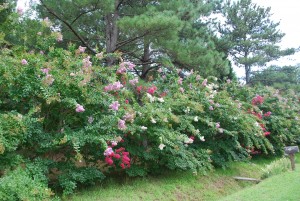My middle daughter used to own a local garden center before she hung up her spade and trowel to join our real estate team. She says that every year at this time, when the crape myrtle trees are in full bloom, dozens of people from out of the area driving down Route 13 would stop into her shop every day to inquire about “those beautiful trees we see along the highway”. (Route 13 is the Eastern Shore’s main highway. It’s the connection to many points North and South on the other side of the famous Chesapeake Bay Bridge and Tunnel , www.cbbt.com , which connects our little peninsula to the Virginia mainland. )
“Those trees” are our brightly colored crape myrtles. Coming into bloom when all the prima donnas flowers of Spring and the more common folk like the plentiful daffodils, azaleas and irises have long faded away, crape myrtle trees bring intense splashes of summer color up and down the Shore. In Northampton County, large portions of Route 13 are lined with these beauties, mostly the pinks and whites, but with lavenders and deep rose as well. Primarily a tree of the south, they don’t do well in colder climates, but here on the Eastern Shore of Virginia, crape myrtles are the beloved blooming beauties of July– and August, and, if we are lucky, a bit of September as well.
If you visit a local nursery usually you can select from one of eleven vibrant colors, ranging from just about every hue from very light pink to a deep, deep rose, plus red and lavander. The “Natchez” variety, which sports large snow white blossoms, makes up for its lack of splashy color by having the most deeply hued bark, almost a burnt sienna hue. The bark and shape of these trees is really quite unusual — normally a light to deep tan, the bark is completely smooth– when you look at the bark you feel the urge to touch it, just to see if it feels as smooth as it looks. In the autumn, as the leaves start falling, the colors of the bark become more accentuated, bringing a different kind of beauty to this singular tree. ( I should mention here that we have a wonderfully moderate but 4 season climate here on the Eastern Shore. Springs and autumns are long and very, very pleasant. The cold part of winter is very short, primarily the month of January, we seldom have snow, virtually never have ice, farmers here start plowing near the end of February. July and August are our only hot months and are absent the soaring humidity so prevalent in our Carolina neighbors.) And as it gets older, the crape myrtle becomes very slightly twisted and gnarled, adding even more character to an already amazing tree.
 But one of the best things about crape myrtles is this— they are so easy to grow ! Anyone can do it ! Even me ! Just stick them in the ground, make sure they have plenty of water in the early months and voila ! they just keep on growing. No fuss, no muss, no bother. They are a lot like our holly trees in that respect, once they take hold they are virtually indestructible, you very nearly can’t kill them even when you want to ! So up and down the Eastern Shore, the hardy crape myrtle tree is an important component for brilliant summer color in any homeowner’s landscaping plan. My personal favorite is to see them lining driveways, especially long, winding driveways. They look like colorful sentries, an immobile honor guard, blushing red, white and pink all the way home, these beloved blooming beauties of July, Virginia Eastern Shore’s spectacular crape myrtle trees.
But one of the best things about crape myrtles is this— they are so easy to grow ! Anyone can do it ! Even me ! Just stick them in the ground, make sure they have plenty of water in the early months and voila ! they just keep on growing. No fuss, no muss, no bother. They are a lot like our holly trees in that respect, once they take hold they are virtually indestructible, you very nearly can’t kill them even when you want to ! So up and down the Eastern Shore, the hardy crape myrtle tree is an important component for brilliant summer color in any homeowner’s landscaping plan. My personal favorite is to see them lining driveways, especially long, winding driveways. They look like colorful sentries, an immobile honor guard, blushing red, white and pink all the way home, these beloved blooming beauties of July, Virginia Eastern Shore’s spectacular crape myrtle trees.

